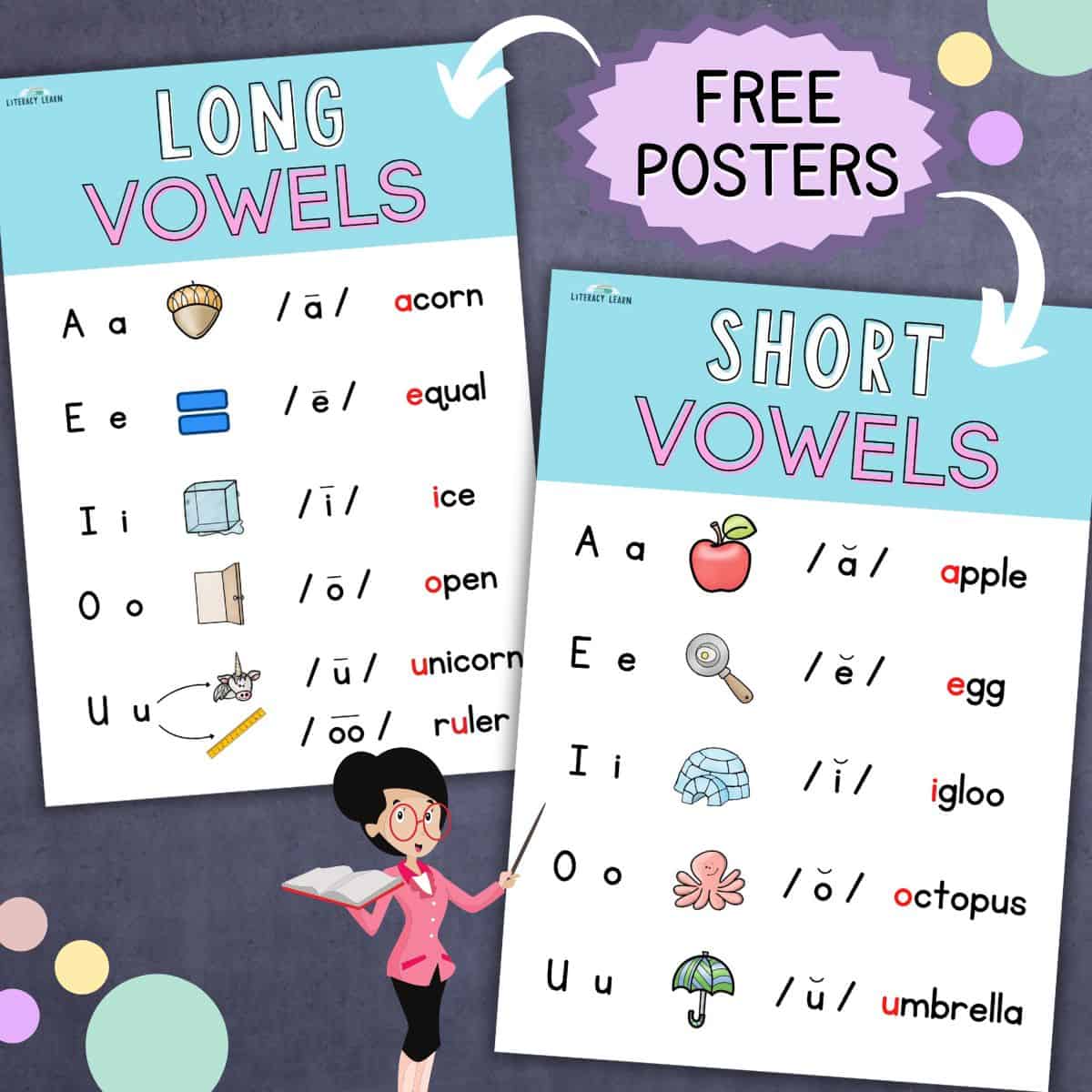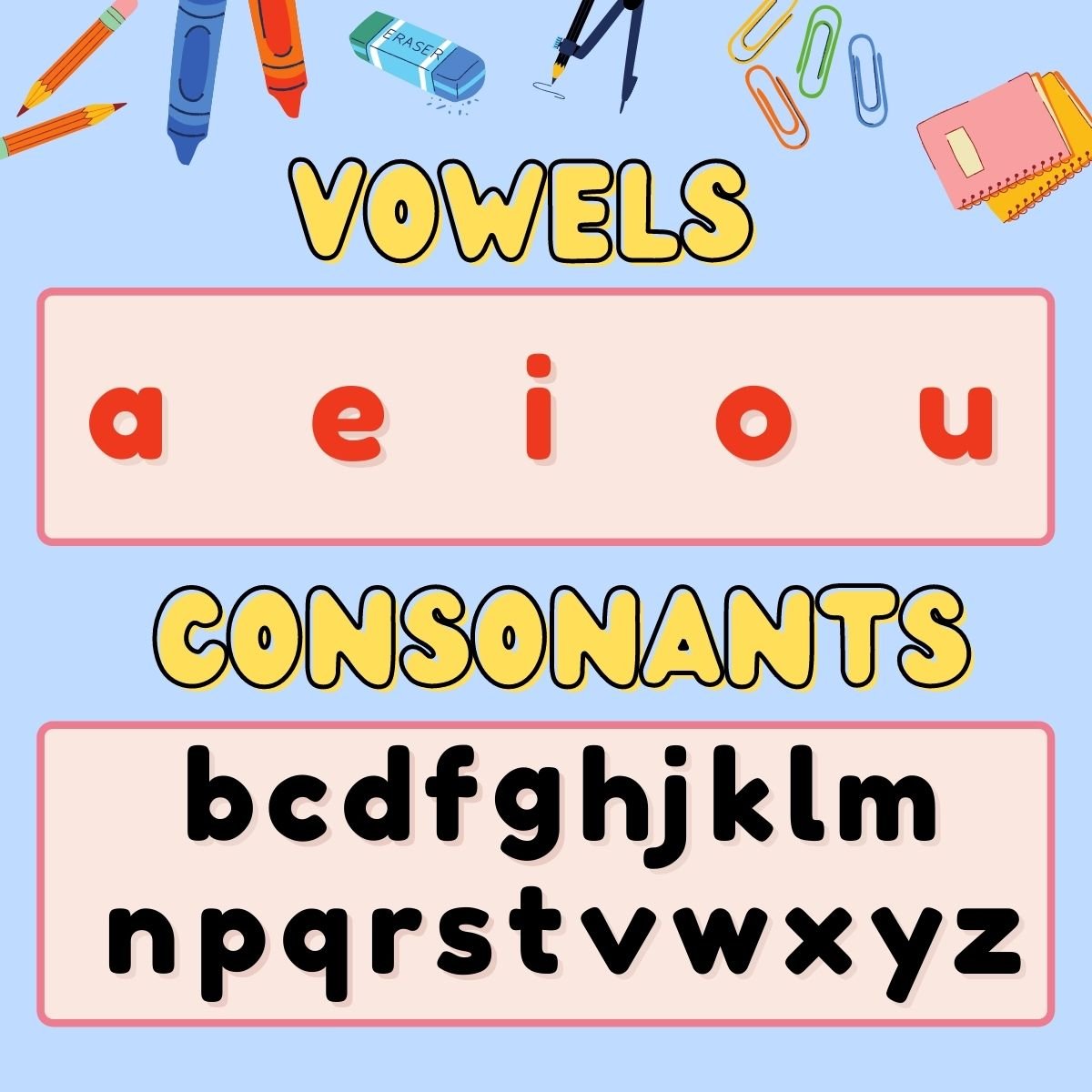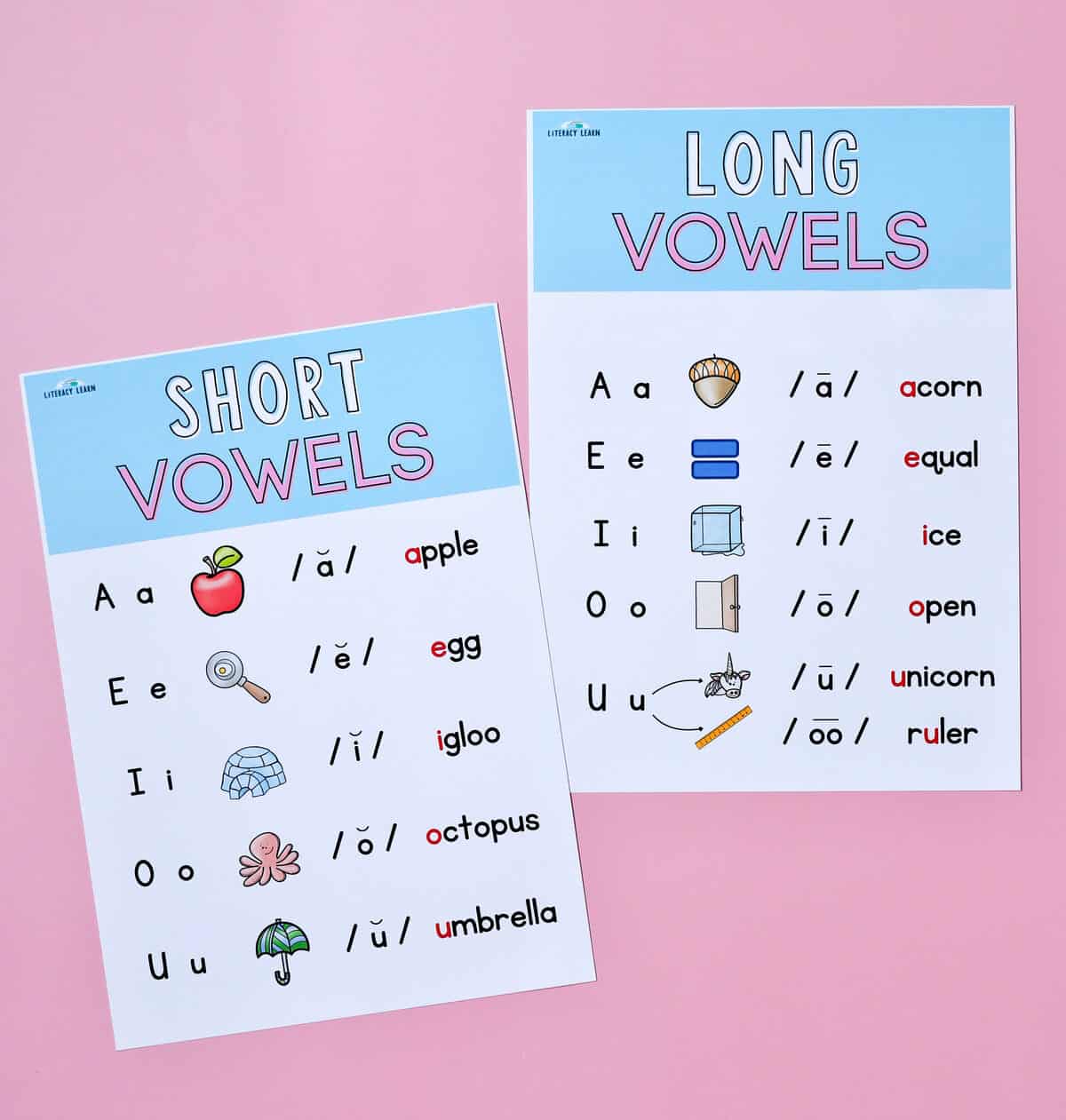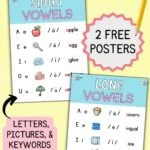Long & Short Vowel Sounds – Plus 2 Free Anchor Charts!
This post may contain affiliate links. As an Amazon affiliate, we earn from qualifying purchases. See our disclosure policy.
Learn the difference between short and long vowels, when to teach these sounds, and the rules for these sounds. For extra classroom help, print the two free vowel anchor charts, with capital and lowercase letters and bright pictures to teach the long and short vowel sounds!

Teaching Long & Short Vowels
Did you know that a vowel is NOT a letter? And a consonant is NOT a letter? Instead, vowels and consonants are actually SOUNDS.
A vowel is a sound that is made with an open mouth, where nothing is blocking or stopping the sound. The jaw will drop open when a vowel sound is made. A vowel sound can be ‘sung’ or ‘yelled’ until you run out of breath (try it!) The graphemes (letters) a, e, i, o, and u represent vowel sounds.
A consonant is a sound that is made when something in the mouth is blocking or slowing down the sound, such as the throat, teeth, tongue, or lips. 21 letters of the alphabet represent consonant sounds, as well as other graphemes like digraphs ch and sh.
Every English syllable MUST include at least one vowel sound. That’s why knowing and practicing vowel sounds is so important when it comes to reading!
Children need to be introduced to the terms ‘vowel’ and ‘consonant’ as early as pre-k, and they should leave kindergarten able to quickly and easily identify the vowels and consonants in words, both orally and within written words.
Having this basic knowledge will help build a solid foundation for the rest of their literacy instruction to be built upon. For more on the 44 phonemes (sounds) of the English language, visit our post on All About Sound Walls.

Short Vowel Sounds
Short vowels are taught the first vowel sounds that should be taught. Begin teaching short vowel sounds in pre-k and continue teaching and reviewing them throughout all of kindergarten and the beginning of first grade.
👉 Rule: When there is one vowel in a word, either at the beginning or between two consonants, it usually has a short vowel sound.
Examples
- Short A words: cat, map, hat, an, flag, bam, rat, fad, had, wag, jab, pan, chap, ram.
- Short E words: leg, leg, pet, slef, hen, men, Zed, net, web, wed, west, hem, fed.
- Short I words: is, in, lip, rim, lip, slid, pin, lick, lob, fin, thin, Tim, pin, fig, fit, hip, hit, whip.
- Short O words: on, not, log, off, blog, mop, Tom, nod, slop, fox, fog, flop, hog, hop frog.
- Short U words: up, ugly, mug, mud, lug, slum, fun, slug, rug, pup, slub, hug, hum, jug, jot.
Long Vowel Sounds
Long vowels are usually taught after the first few months of first grade.
Students should have a firm command reading words with short vowels, digraphs, consonant blends, and closed syllables before long vowels are introduced. They’ll continue learning long vowel spellings throughout the next few years of elementary school.
👉 Rule: Long vowels say their name.
Long vowel sounds can be heard at the beginning, middle, or end of a word. Long vowels can be spelled with a silent e (VCe pattern), a vowel team, or in an open syllable.
👉 Although there are many different long vowel spellings, I focus heavily on the ones we find most frequently in text, marked with an asterisk (*) below! Use our long vowel sounds worksheets to give students more practice!
Long A
There are 8 ways to spell Long A:
- a like baby*
- a-e like cake*
- ai like rain*
- ay like day*
- ei like reindeer
- eigh like eight
- ea like steak
- ey like hey
Long E
There are 8 ways to spell Long E:
- e like equal*
- e-e like scere*
- ee like bee*
- ea like read*
- y like baby*
- ei like receipt
- ie like cookie
- ey like turkey
Long U
Long u can actually make TWO sounds: ū (yoo) and ū (oo).
There are 5 ways to spell Long ū (yoo):
- u like unicorn*
- u-e like mute*
- ue like argue*
- ew like curfew*
- eu like eucalyptus
There are 7 ways to spell Long ū (oo):
- u like ruler*
- u-e like tube*
- ue like glue*
- ew like stew*
- oo like balloon
- ou like soup
- ui like fruit
👉 Tip: Do not teach all of the spellings above at one time. Instead, follow a systematic approach for teaching the spellings listed above.
Work on one spelling pattern at a time until students have mastered it, then move on.
If you don’t know where to start, the book Recipe for Reading helps parents and teachers practically implement Orton Gillingham methodology with students. It’s one of my favorite Science of Reading-aligned books!

Printable Anchor Charts
To help teach these concepts to kids, print both of the two free posters that can be used as anchor charts. One is focused on short vowel sounds and the other is focused on long vowel sounds.
The posters are designed to help promote both uppercase and lowercase recognition for each of the five vowels.
Each poster includes a bright picture that matches the keyword and includes the vowel sound.
Both posters use words where the vowel sounds are found at the beginning, allowing kids to hear and identify beginning sounds in words.
Short Vowel Poster
- A a – /ă/ – apple
- E e – /ĕ/ – egg
- I i – /ĭ/ – igloo
- O o – /ŏ/ – octopus
- U u – /ŭ/ – umbrella
Long Vowel Poster
- A a – /ā/ – acorn
- E e – /ē / – equal
- I i – /ī/ – ice
- O o – /ō/ – open
- U u – /ū/ – unicorn and /oo/ like ruler.
Related Posts
- CVC Word Families Anchor Chart
- All About Open and Closed Syllables
- Long Vowel Word Lists: A, E, I, O, and U.
- All About Word Ladders
Download & Print
We’d love to hear about your experience using these anchor charts!
Please leave a comment below or tag us on Instagram @literacylearn.
DOWNLOAD TERMS: All of our resources and printables are designed for personal use only in homes and classrooms. Each teacher must download his or her own copy. Please do not save to a shared drive, reproduce our resources on the web, or make photocopies for anyone besides your own students. To share with others, please use the social share links provided or distribute the link to the blog post so others can download their own copies. Your support in this allows us to keep making free resources for everyone! Please see our Creative Credits page for information about the licensed clipart we use. If you have any questions or concerns regarding our terms, please email us. Thank you!

